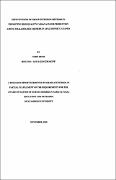| dc.description.abstract | Smallholder farmers of Apac District received advice from extension agents on the production of
high quality cassava flour from 2009 to 2015. Despite training, production remained low at 4000kg
ha·1 compared to the expected output of 8000kg ha· 1
, which called for an investigation conceived to
establish the effectiveness of the group extension methods used in training for high output. A cross sectional
survey design was used. Interviews, questionnaires, observations and focused group
discussions were used to collect data from a total of 133 respondents consisting of 126 farmers
randomly selected from 185 farmers trained. Additionally, seven extension agents completed
questionnaires and were interviewed. Using SPSS version 16.0, the data collected was processed to
determine frequencies, percentages, cross tabulations and chi-square test. Results show 64% of the
famers participated in demonstrations, 73% in field days and 75% in exchange visits. Cross
tabulations showed that demonstrations benefited 59% of the farmers in using clean water for
processing; field days benefited 65% of the farmers in practicing timely harvesting and exchange
visits benefited only 19% in using recommended varieties at planting. The framers whose flour was
rejected at sale were: 20% for lack of follow up after training, 14% for reduced training hours and
13% for high speed content delivery. Chi-square showed significant association at O.Ola between
farmers participation in demonstrations and knowledge in site selection for cassava production.
Most farmers acquired more knowledge from group demonstrations, followed by field days and
exchange visits respectively. Methods were effective in practices such as site selection, timely
harvesting, use of clean water but not effective in post-harvest handling. Trainers of farmers should
keep group size to 6 while combining methods for chipping and post-harvest handling. Time
duration and frequency of training should be optimum farmers to produce high quality cassava
flour. | en_US |

